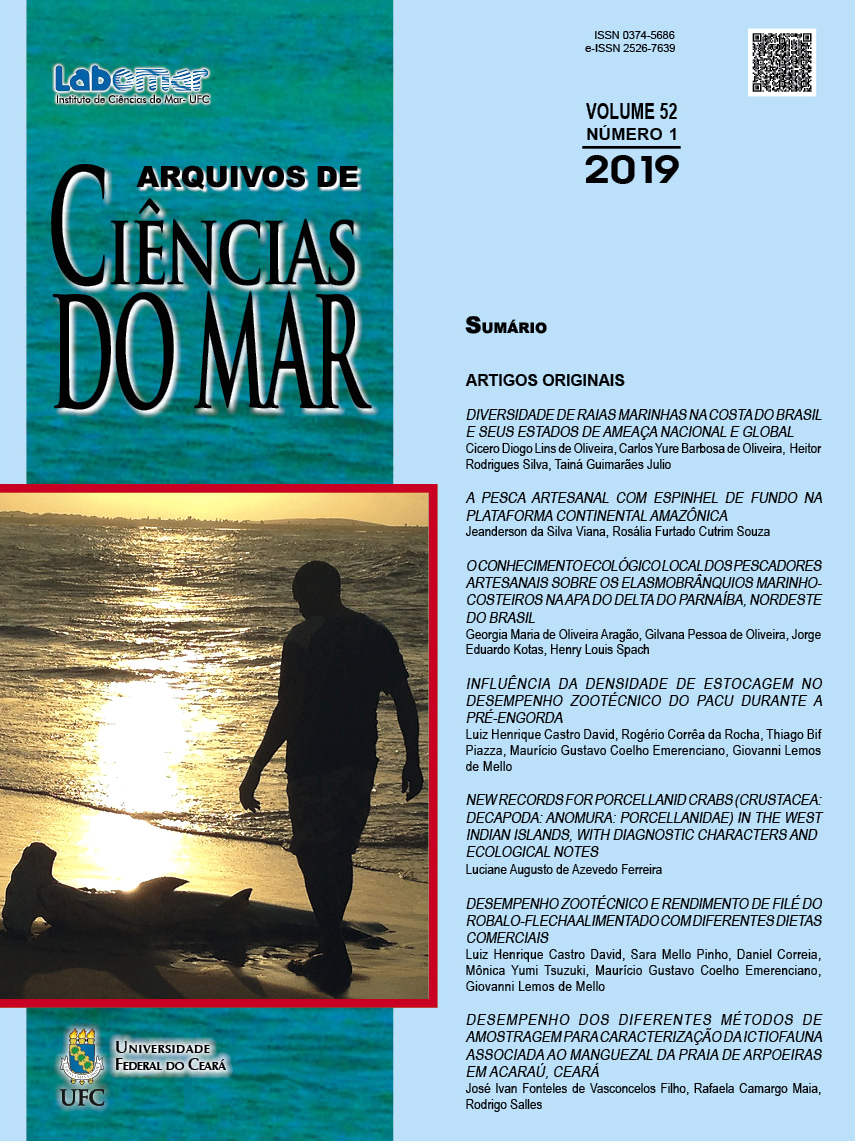Ethnoconservational implications regarding informal shellfish management Anomalocardia flexuosa (Linnaeus, 1767) by shellfish gathering women
DOI:
https://doi.org/10.32360/acmar.v52i1.40966Abstract
The mollusk gathering activity can be understood as the artisanal fishing of molluscs, where their management can be carried out manually or with the aid of fishing gear being the main one for the Northeast region the exploitation and commercialization of shellfish (Anomalocardia flexuosa). The objective of this work was to analyze the practice of the informal management of shellfish, manually collected by mollusk gathering in the northeast coast of Brazil. The study site was the Acaú-Goiana Extractive Reserve, located between the states of Pernambuco and Paraíba. The research was carried out during the years 2017 and 2018, consisting of immersions and random visits in the communities of Acaú and Carne de Vaca, based on participant observation. From the separation in the small and large sizes, adopted by the mollusk gathering, measurements were made for the height, length and width of the shells. A total of 11 shellfish were culled and separated from the mollusk gathering, totaling 1793 shellfish, totalizing of 1,793 selfish, 685 small (discarded) and 1108 gross. The size of intersection between picking or discarding shellfish occurs with sizes from 18 to 20mm for the overall length, which is biologically sustainable. This action results in a reduction of the overfishing process, since the seafood caught is already sexually adult, that is, they have already passed through the process of reproduction, and the despised can
Keywords: conservation unit, fishing community, conservation, artisanal fishing.
Downloads
References
BANDEIRA, F. O.; CAMARGO, M.; RAMOS, J. A. A.; ESTUPINAN, R.; SANTOS, A. P. S. Parâmetros biométricos de Anomalocardia flexuosa (Linnaeus, 1767) – Bivalvia – Veneridae no estuário do Rio Paraíba – PB. Gaia Scientia, v.11, n.2, p.242-249, 2017.
BARBOSA, J. A. A.; AGUIAR, J. O. Etnoconservação e história ambiental para um novo modelo conservacionista do século XXI. Novos Cadernos NAEA, v.21, n.1, p.243-255, 2018.
BARREIRA, C. A. R.; ARAÚJO, M. L. R. Ciclo reprodutivo de Anomalocardia brasiliana (Gmelin, 1791) (Mollusca, Bivalvia, Veneridae) na praia do canto da barra, Fortim, Ceará, Brasil. Boletim do Instituto de Pesca, v.31, n.1, p.9-20, 2005.
BERKES, F. Sacred ecology: traditional ecological knowledge and management systems. Taylor & Francis, 1999.
BEZERRIL, G. Trabalho no mangue: os saberes e a busca por valorização das marisqueiras de Fortim – Ceará. Cadernos do LEME, v.4, n.1, p.5-33, 2012.
CAETANO, H. S. Da ocupação do território: práticas e interações entre marisqueiras no ambiente pesqueiro. Revista de Gestão e Sustentabilidade Ambiental, v.3, n.2, p.204-222, 2015.
CIDREIRA-NETO, I. R. G.; NASCIMENTO, D. M.; MORAES, P. X.; RODRIGUES, G. G. Análise biométrica de Anomalocardia flexuosa em Área de Proteção Ambiental. Journal Environmental Analysis and Progress, v.3, n.2, p.191-199, 2018.
DIAS, T. L. P.; ROSA, R. S.; DAMASCENO, L. C. P. Aspectos socioeconômicos, percepção ambiental e perspectivas das mulheres marisqueiras da Reserva de Desenvolvimento Sustentável Ponta do Tubarão (Rio Grande do Norte, Brasil). Gaia Scientia, v.1, n.1, p.25-35, 2007.
DIEGUES, A. C. S. Pescadores, Camponeses e Trabalhadores do Mar. São Paulo: Ática, 1983.
DIEGUES, A. C. Etnoconservação: novos rumos para a proteção da natureza nos trópicos. 2000.
GIL, A. C. Métodos e técnicas de pesquisa social. Editora Atlas: 2008.
LIMA, M.E.A.; SELVA, V.S.F.; RODRIGUES, G.G. Gestão participativa nas reservas extrativistas: a atuação do Instituto Chico Mendes da Biodiversidade. Revista Brasileira de Geografia Física, v.9, n.4, p.1072-1087, 2016.
LOPÉZ-ROCHA, J.A.; MELO, F.J.F.R.; GASTÉLUM-NAVA, E.; LARIOS-CASTRO, E.; ROMO-PIÑERA, A. Morphometric relationship, growth parameters, and natural mortality as estimated primary inputs for fishery management in newfishing areas for bivalve molluscs (BIVALVIA: VENERIDAE). Journal os Shellfish Research, v.37, n.3, p.591-600, 2018.
NASCIMENTO, C.H.V.; CIDREIRA-NETO, I.R.G.; SILVA, R.P.; ASSIS, J.E.; GUSMÃO, N.B.; RODRIGUES, G.G. Caracterização morfométrica e microbiota endógena de populações do marisco Anomalocardia flexuasa Linnaeus, 1767 (Bivalvia: Veneridae). Journal Environmental Analysis and Progress, v.3, n.3, p.275-286, 2018.
NISHIDA, A. K.; NORDI, N.; ALVES, R. R. N. Abordagem etnoecológica da coleta de moluscos no litoral paraibano. Tropical Oceanography, v.32, n.1, p.53-68, 2004.
PALHETA, M. K. S.; CANETE, V. R.; CARDOSO, D. M. Mulher e mercado: participação e conhecimentos femininos na inserção de novas espécies de pescado no mercado e na dieta alimentar dos pescadores da RESEX Mãe Grande em Curuçá (PA). Boletim do Museu Paraense Emílio Goeldi, v.11, n.3, p.601-619, 2016.
PEREIRA, B. E.; DIEGUES, A. C. Conhecimento de populações tradicionais como possibilidade de conservação da natureza: uma reflexão sobre a perspectiva da etnoconservação. Revista de Desenvolvimento e Meio Ambiente, n.22, p.37-50, 2010.
SILVA, M. S. F.; ALMEIDA, G. L. O uso do potencial fitogeográfico pelas comunidades tradicionais em Indiaroba-SE. REGNE, v.2, 2016.
SILVA, J.S.; MARTINS, I.X. A pesca de moluscos em ambientes intermareais no oeste do Estado do Rio Grande do Norte, Brasil. Arquivos de Ciência do Mar, v.50, n.2, p.110-118, 2017.
SOUTO, F. J. B.; MARTINS, V. S. Conhecimentos etnoecológicos na mariscagem de moluscos bivalves no manguezal do distrito de Acupe, Santo Amaro – BA. Biotemas, v.22, n.4, p.207-208, 2009.
Downloads
Published
Issue
Section
License
1. Proposta de Política para Periódicos de Acesso Livre
Autores que publicam nesta revista concordam com os seguintes termos:
- Autores mantém os direitos autorais e concedem à revista o direito de primeira publicação, com o trabalho simultaneamente licenciado sob a Licença Creative Commons Attribution que permite o compartilhamento do trabalho com reconhecimento da autoria e publicação inicial nesta revista.
- Autores têm autorização para assumir contratos adicionais separadamente, para distribuição não-exclusiva da versão do trabalho publicada nesta revista (ex.: publicar em repositório institucional ou como capítulo de livro), com reconhecimento de autoria e publicação inicial nesta revista.
- Autores têm permissão e são estimulados a publicar e distribuir seu trabalho online (ex.: em repositórios institucionais ou na sua página pessoal) a qualquer ponto antes ou durante o processo editorial, já que isso pode gerar alterações produtivas, bem como aumentar o impacto e a citação do trabalho publicado (Veja O Efeito do Acesso Livre).

